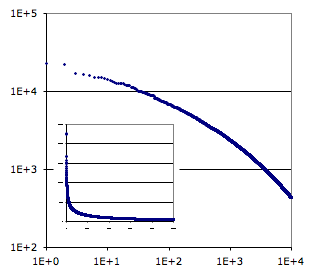Another example for my collection of power law distributions. The data is taken from CiteSeer. It shows the most attractive ten thousand computer scientists. Where attractive means that their papers attracted bibliographic citations. This is normalized by publication year, what ever that means? I feel guilty about posting this one. This kind of competition is extremely toxic to collaboration.

The flat bits on the curve appear to be coauthor pairs. The gentle bow to the curve suggests that something regulatory starts to kick in toward the top. If I had data I presume the curve would become more stern.
Somebody must have computed slope of this curve for different academic domains. The shape over time would be even more interesting. Assuming one has a choice about one’s calling, wouldn’t that be valuable input to the decision?
I am not on this list. therefore its invalid. Actually, I studied under milner (25) and worked with Steve Whittaker (who spent all the time writing papers).
Interesting to see that ullman comes in so high, and Turing less so. Why Ullman? I’d have to see what he did other than the compiler book.
I presume that Turning falls off the list because the “normalized by publication year” bakes in a prejudice that the young are attractive than the dead.
Pingback: Ascription is an Anathema to any Enthusiasm » Blog Archive »